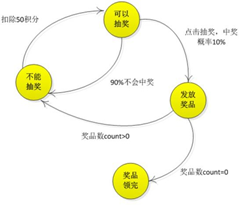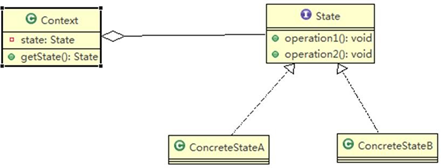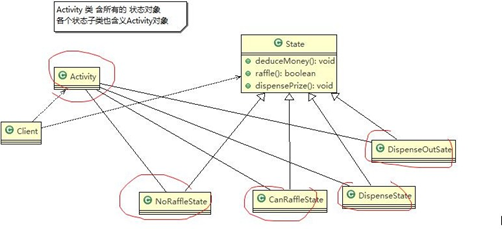设计模式——状态模式
1:APP 抽奖活动问题
请编写程序完成 APP 抽奖活动 具体要求如下:
1) 假如每参加一次这个活动要扣除用户 50 积分,中奖概率是 10%
2) 奖品数量固定,抽完就不能抽奖
3) 活动有四个状态: 可以抽奖、不能抽奖、发放奖品和奖品领完
4) 活动的四个状态转换关系图(右图)

2 :状态模式基本介绍
基本介绍
1) 状态模式(State Pattern):它主要用来解决对象在多种状态转换时,需要对外输出不同的行为的问题。状态和行为是一一对应的,状态之间可以相互转换
2) 当一个对象的内在状态改变时,允许改变其行为,这个对象看起来像是改变了其类
3 状态模式的原理类图

- 对原理类图的说明-即(状态模式的角色及职责)
1) Context 类为环境角色, 用于维护 State 实例,这个实例定义当前状态
2) State 是抽象状态角色,定义一个接口封装与 Context 的一个特点接口相关行为
3) ConcreteState 具体的状态角色,每个子类实现一个与 Context 的一个状态相关行为
4 状态模式解决 APP 抽奖问
1) 应用实例要求
完成 APP 抽奖活动项目,使用状态模式.
2) 思路分析和图解(类图)
-定义出一个接口叫状态接口,每个状态都实现它。
-接口有扣除积分方法、抽奖方法、发放奖品方法

3) 代码
1 package com.atguigu.state; 2 3 4 5 import java.util.Random; 6 7 8 9 /** 10 11 * 可以抽奖的状态 12 13 * @author Administrator 14 15 * 16 17 */ 18 19 public class CanRaffleState extends State { 20 21 22 23 RaffleActivity activity; 24 25 26 27 public CanRaffleState(RaffleActivity activity) { this.activity = activity; 28 29 } 30 31 32 33 //已经扣除了积分,不能再扣 @Override 34 35 public void deductMoney() { 36 37 System.out.println("已经扣取过了积分"); 38 39 } 40 41 //可以抽奖, 抽完奖后,根据实际情况,改成新的状态 42 43 @Override 44 45 public boolean raffle() { System.out.println("正在抽奖,请稍等!"); Random r = new Random(); 46 47 int num = r.nextInt(10); 48 49 // 10%中奖机会if(num == 0){ 50 51 // 改 变 活 动 状 态 为 发 放 奖 品 context activity.setState(activity.getDispenseState()); 52 53 return true; 54 55 }else{ 56 57 System.out.println("很遗憾没有抽中奖品!"); 58 59 // 改变状态为不能抽奖 60 61 activity.setState(activity.getNoRafflleState()); return false; 62 63 } 64 65 } 66 67 68 69 // 不能发放奖品 70 71 @Override 72 73 public void dispensePrize() { 74 75 System.out.println("没中奖,不能发放奖品"); 76 77 } 78 79 }
1 package com.atguigu.state; 2 3 4 5 6 7 /** 8 9 * 状态模式测试类 10 11 * @author Administrator 12 13 * 14 15 */ 16 17 public class ClientTest { 18 19 20 21 public static void main(String[] args) { 22 23 // TODO Auto-generated method stub 24 25 // 创建活动对象,奖品有 1 个奖品 26 27 RaffleActivity activity = new RaffleActivity(1); 28 29 30 31 // 我们连续抽 300 次奖 32 33 for (int i = 0; i < 30; i++) { 34 35 System.out.println("--------第" + (i + 1) + "次抽奖----------"); 36 37 // 参加抽奖,第一步点击扣除积分 38 39 activity.debuctMoney(); 40 41 42 43 // 第二步抽奖 44 45 activity.raffle(); 46 47 } 48 49 } 50 51 52 53 54 55 }
1 package com.atguigu.state; 2 3 /** 4 5 * 奖品发放完毕状态 6 7 * 说明,当我们 activity 改变成 DispenseOutState, 抽奖活动结束 8 9 * @author Administrator 10 11 * 12 13 */ 14 15 public class DispenseOutState extends State { 16 17 18 19 // 初始化时传入活动引用 20 21 RaffleActivity activity; 22 23 24 25 public DispenseOutState(RaffleActivity activity) { this.activity = activity; 26 27 } 28 29 @Override 30 31 public void deductMoney() { 32 33 System.out.println("奖品发送完了,请下次再参加"); 34 35 } 36 37 38 39 40 41 @Override 42 43 public boolean raffle() { 44 45 System.out.println("奖品发送完了,请下次再参加"); return false; 46 47 } 48 49 50 51 52 53 @Override 54 55 public void dispensePrize() { 56 57 System.out.println("奖品发送完了,请下次再参加"); 58 59 } 60 61 }
1 package com.atguigu.state; 2 3 4 /** 5 * 发放奖品的状态 6 * @author Administrator 7 * 8 */ 9 public class DispenseState extends State { 10 11 // 初始化时传入活动引用,发放奖品后改变其状态 12 RaffleActivity activity; 13 14 15 public DispenseState(RaffleActivity activity) { this.activity = activity; 16 } 17 @Override 18 public void deductMoney() { 19 System.out.println("不能扣除积分"); 20 } 21 22 23 @Override 24 public boolean raffle() { 25 System.out.println("不能抽奖"); return false; 26 } 27 28 //发放奖品 @Override 29 public void dispensePrize() { if(activity.getCount() > 0){ 30 System.out.println("恭喜中奖了"); 31 // 改变状态为不能抽奖 32 activity.setState(activity.getNoRafflleState()); 33 }else{ 34 System.out.println("很遗憾,奖品发送完了"); 35 // 改变状态为奖品发送完毕, 后面我们就不可以抽奖 36 activity.setState(activity.getDispensOutState()); 37 //System.out.println("抽奖活动结束"); 38 //System.exit(0); 39 } 40 } 41 }
1 package com.atguigu.state; 2 3 4 /** 5 * 不能抽奖状态 6 * @author Administrator 7 * 8 */ 9 public class NoRaffleState extends State { 10 11 // 初始化时传入活动引用,扣除积分后改变其状态 12 RaffleActivity activity; 13 14 15 public NoRaffleState(RaffleActivity activity) { this.activity = activity; 16 } 17 18 // 当前状态可以扣积分 , 扣除后,将状态设置成可以抽奖状态 19 @Override 20 public void deductMoney() { 21 System.out.println("扣除 50 积分成功,您可以抽奖了"); activity.setState(activity.getCanRaffleState()); 22 } 23 // 当前状态不能抽奖 24 @Override 25 public boolean raffle() { 26 System.out.println("扣了积分才能抽奖喔!"); return false; 27 } 28 29 // 当前状态不能发奖品 30 @Override 31 public void dispensePrize() { 32 System.out.println("不能发放奖品"); 33 } 34 }
1 package com.atguigu.state; 2 3 4 /** 5 * 抽奖活动 // 6 * 7 * @author Administrator 8 * 9 */ 10 public class RaffleActivity { 11 12 // state 表示活动当前的状态,是变化 13 State state = null; 14 // 奖品数量 15 int count = 0; 16 17 // 四个属性,表示四种状态 18 State noRafflleState = new NoRaffleState(this); State canRaffleState = new CanRaffleState(this); 19 20 State dispenseState = new DispenseState(this); State dispensOutState = new DispenseOutState(this); 21 22 //构造器 23 //1. 初始化当前的状态为 noRafflleState(即不能抽奖的状态) 24 //2. 初始化奖品的数量 25 public RaffleActivity( int count) { this.state = getNoRafflleState(); this.count = count; 26 } 27 28 //扣分, 调用当前状态的 deductMoney public void debuctMoney(){ 29 state.deductMoney(); 30 } 31 32 //抽奖 33 public void raffle(){ 34 // 如果当前的状态是抽奖成功 35 if(state.raffle()){ 36 //领取奖品state.dispensePrize(); 37 } 38 39 40 } 41 42 43 public State getState() { return state; 44 } 45 46 47 public void setState(State state) { this.state = state; 48 } 49 50 //这里请大家注意,每领取一次奖品,count-- public int getCount() { 51 int curCount = count; count--; 52 return curCount; 53 } 54 55 56 public void setCount(int count) { this.count = count; 57 } 58 public State getNoRafflleState() { return noRafflleState; 59 } 60 61 62 public void setNoRafflleState(State noRafflleState) { this.noRafflleState = noRafflleState; 63 } 64 65 66 public State getCanRaffleState() { return canRaffleState; 67 } 68 69 70 public void setCanRaffleState(State canRaffleState) { this.canRaffleState = canRaffleState; 71 } 72 73 74 public State getDispenseState() { return dispenseState; 75 } 76 77 78 public void setDispenseState(State dispenseState) { this.dispenseState = dispenseState; 79 } 80 81 public State getDispensOutState() { return dispensOutState; 82 } 83 84 85 public void setDispensOutState(State dispensOutState) { this.dispensOutState = dispensOutState; 86 } 87 }
1 package com.atguigu.state; 2 3 4 /** 5 * 状态抽象类 6 * @author Administrator 7 * 8 */ 9 public abstract class State { 10 11 12 13 // 扣除积分 - 50 14 public abstract void deductMoney(); 15 16 // 是否抽中奖品 17 public abstract boolean raffle(); 18 19 // 发放奖品 20 public abstract void dispensePrize();
21 }
6 状态模式的注意事项和细节
1) 代码有很强的可读性。状态模式将每个状态的行为封装到对应的一个类中
2) 方便维护。将容易产生问题的 if-else 语句删除了,如果把每个状态的行为都放到一个类中,每次调用方法时都要判断当前是什么状态,不但会产出很多 if-else 语句,而且容易出错
3) 符合“开闭原则”。容易增删状态
4) 会产生很多类。每个状态都要一个对应的类,当状态过多时会产生很多类,加大维护难度
5) 应用场景:当一个事件或者对象有很多种状态,状态之间会相互转换,对不同的状态要求有不同的行为的时候, 可以考虑使用状态模式


